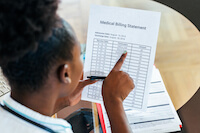Why You Should Always Get an Itemized Hospital Bill
When it comes to healthcare, sometimes it makes sense to get a second opinion. But when it comes to medical expenses, you should always get an...

After an illness or injury, receiving a large medical bill in the mail can be an eye-opening experience. Substantial charges can add to an already distressing situation, and the consequences of unpaid bills or late payments can create a negative domino effect no patient wants to deal with.
Medical bills can be confusing, and knowing if you are being charged correctly can be difficult. Unfortunately, medical billing errors do happen, but preparing for and responding to these situations is easier with a little guidance.

Estimates suggest up to 80 percent of all medical bills contain some kind of error. Despite the prevalence of these mistakes, it can be difficult for patients to identify incorrect charges on their bills. To understand why medical billing errors happen, it is important to look at the wide range of factors that can cause them.
One major reason for medical billing errors is simple human error. Medical staff might make unintentional mistakes when entering patient information into a computer system or filling out paper forms.
Lack of training, workplace stress, fatigue or simple slip-ups such as transposition errors can lead to mistakes when filling out charts and other paperwork. Mistakes can also happen when there is miscommunication between departments of hospitals.
Our modern healthcare system’s complex nature can also lead to medical billing errors. For example, healthcare providers must assign specific procedure and diagnosis codes to each service they provide, and these codes must correspond with what is actually provided or billed for. An incorrect code can result in inaccurate payments or overcharging.
Since there are numerous different players involved in the healthcare industry, different procedures, rules and regulations can lead to a tangled web that makes it difficult for everyone involved in the process to keep track of policy changes, which can lead to mistakes made along the way.
One proactive measure you can take to navigate the complex world of medical costs is asking for an itemized hospital bill. This will break each procedure or exam down line by line so you can analyze what was done and how much it cost. Getting a detailed invoice, rather than a summary of services performed, will help you spot any discrepancies or errors at a glance.
Your medical center’s billing department can handle providing this type of bill to you, so do not be afraid to ask. Additionally, here are five steps you can follow when you receive your bill to ensure you are not being overcharged or billed incorrectly.
1. Check the Date of Service
Look at the date printed on the bill and length of stay, if it is included. Overnight visits will cost you more, so if you were in the emergency room for only a few hours, make sure your bill does not state you were there all day or night. Check that the services listed on the bill were provided on the date of service that is listed. If there are any discrepancies, it could be a sign of incorrect charges.
2. Compare the Bill to Your Medical Records
Review your medical records to cross-reference the care you received with what is listed on your bill. If you notice any discrepancies, bring them to the attention of your healthcare provider. If there is a service listed that you remember refusing or not receiving, it should not be included.
Take a look at each service listed on the bill. Make sure that the charges are consistent with the prices that you were quoted or that are typical for the area in which you received care. If the charges seem excessive, it could be a sign of a medical billing error.
Data entry errors can lead to the same item and charge being printed multiple times on your bill. Review your bill carefully to avoid paying for the same service more than once.
While a little more complex, researching medical codes and comparing them to those listed on your bill could help you identify any mistakes or fraudulent charges. Mistakes happen, but intentional upcharging—called “upcoding”—is a real issue and violation of federal law.
Protect yourself by accessing the Current Procedural Terminology (CPT) coding system physicians use and making sure there are no errors or discrepancies on your bill.
When you find issues or inconsistencies within your medical bill, the best thing to do is to contact the provider who sent you the bill. Speak with someone in the billing department, and review your itemized list of any discrepancies that you noticed.

Explain why you believe something is an error and provide supporting evidence if possible. Do not be afraid to ask questions or bring up any issues you find.
Keep track of all doctor and hospital bills received, payments made and correspondence between yourself and your provider. Staying organized and diligent can help you avoid paying too much for your healthcare costs.
If you are concerned about medical expenses, you are not alone. Liberty HealthShare is not an insurance company. It is a Christian, non-profit ministry that enables its members to voluntarily share the burden of medical costs among a like-minded community.
We believe that financial limitations should not impede access to quality healthcare. That's why we provide a solution that empowers you to take charge of your health and receive superior medical care. Contact us today to learn what options are best for you.

When it comes to healthcare, sometimes it makes sense to get a second opinion. But when it comes to medical expenses, you should always get an...

Liberty HealthShare and Maternity Preparing for the arrival of your little one is very exciting, but it can feel overwhelming at times, especially...

Your Liberty HealthShare community is here to support you through all phases of your healthcare needs. This includes when you meet the requirements...